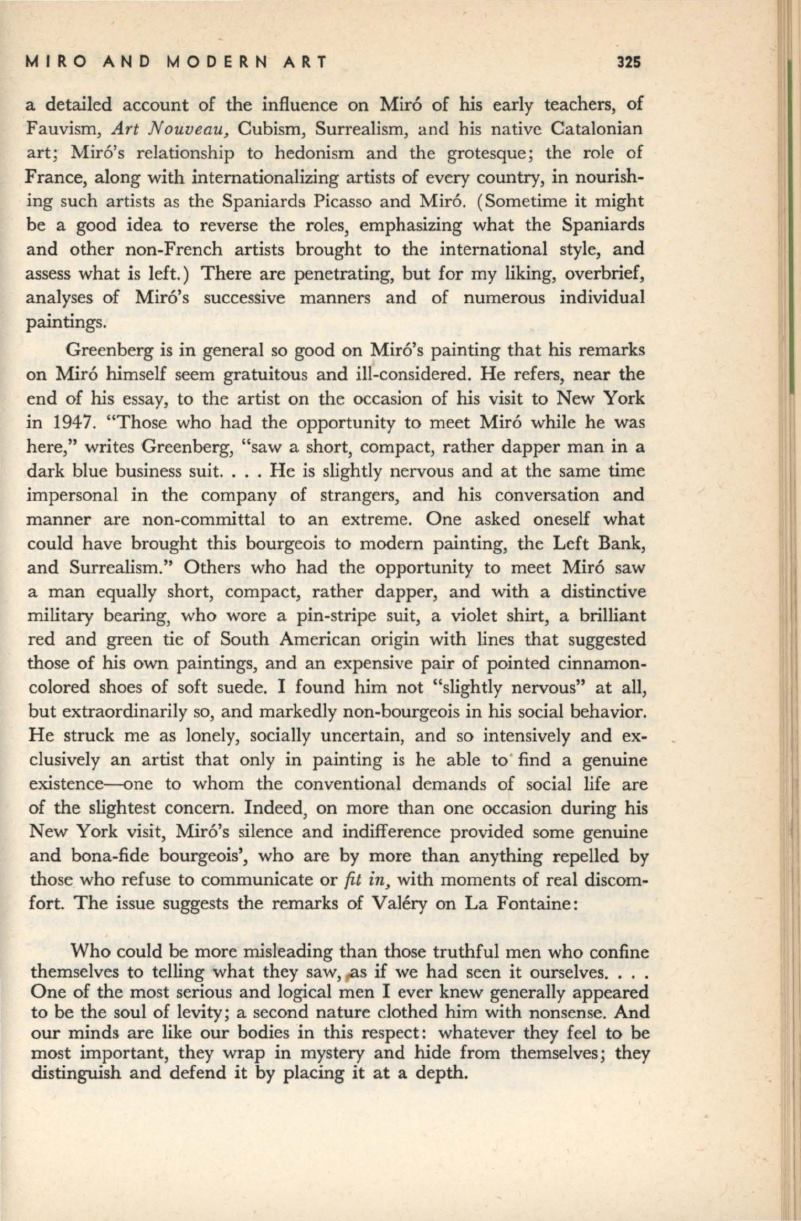
MIRO AND MODERN ART
325
a detailed account of the influence on
Mira
of his early teachers, of
Fauvism,
Art Nouveau,
Cubism, Surrealism, and his native Catalonian
art; Mira's relationship to hedonism and the grotesque; the role of
France, along with internationalizing artists of every country, in nourish–
ing such artists as the Spaniards Picasso and Mira. (Sometime it might
be a good idea to reverse the roles, emphasizing what the Spaniards
and other non-French artists brought to the international style, and
assess what is left.) There are penetrating, but for my liking, overbrief,
analyses of Mira's successive manners and of numerous individual
paintings.
Greenberg is in general so good on Mira's painting that his remarks
on Mira himself seem gratuitous and ill-considered. He refers, near the
end of his essay, to the artist on the occasion of his visit to New York
in 1947. "Those who had the opportunity to meet Mira while he was
here," writes Greenberg, "saw a short, compact, rather dapper man in a
dark blue business suit.... He is slightly nervous and at the same time
impersonal in the company of strangers, and his conversation and
manner are non-committal to an extreme. One asked oneself what
could have brought this bourgeois to modern painting, the Left Bank,
and Surrealism." Others who had the opportunity to meet Mira saw
a man equally short, compact, rather dapper, and with a distinctive
military bearing, who wore a pin-stripe suit, a violet shirt, a brilliant
red and green tie of South American origin with lines that suggested
those of his own paintings, and an expensive pair of pointed cinnamon–
colored shoes of soft suede. I found him not "slightly nervous" at all,
but extraordinarily so, and markedly non-bourgeois in his social behavior.
He struck me as lonely, socially uncertain, and so intensively and ex–
clusively an artist that only in painting is he able to' find a genuine
existence--one to whom the conventional demands of social life are
of the slightest concern. Indeed, on more than one occasion during his
New York visit, Mira's silence and indifference provided some genuine
and bona-fide bourgeois', who are by more than anything repelled by
those who refuse to communicate or
fit
in,
with moments of real discom–
fort. The issue suggests the remarks of Valery on La Fontaine:
Who could be more misleading than those truthful men who confine
themselves to telling what they saw, s if we had seen it ourselves....
One of the most serious and logical men I ever knew generally appeared
to be the soul of levity; a second nature clothed him with nonsense.
And
our minds are like our bodies in this respect: whatever they feel to be
most important, they wrap in mystery and hide from themselves; they
distinguish and defend
it
by placing it at a depth.


